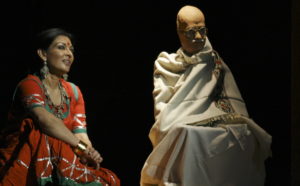Mallika Sarabhai: “I was a social activist even before I knew what it meant”

By Neeru Saluja
As a dancer, storyteller, writer and social activist, Mallika Sarabhai has powered change through performing arts. Besides being one of the leading exponents in classical dance, she is also vocal on women’s empowerment, making her a fearless feminist of our times.
She is also the director of Darpana Academy of Performing Arts ”“ established by her mother Mrinalini in 1949 that has helped shape the dance vocabulary of uncountable students.
She is now performing at Asia TOPA with SVA Kranti: The Revolution Within, where she brings multimedia, theatre, music and dance to conjure an imagined conversation with Mahatma Gandhi through the prism of a 21st century woman.
Excerpts from our interview with her before the show on 28 February in Melbourne:

How would you describe the revolutionary journey of SVA Kranti as an activist and storyteller?
I had taken on the government of Gujarat after the genocide against the Muslims in 2002. I was threatened, we had hooligans try to burn down the institution, I had false cases filed against me. I had to go incognito and into hiding. And all I was trying to do was to get justice for a group of Indian citizens who were being deprived of their rights. They were terrifying times and I used to have these conversations in my head with Gandhiji. That is where this piece comes from. And the fun thing is that today there is nowhere in the world where there are no non-violent protests a la Gandhi.
Your journey internationally grew when you played the role of Draupadi in Peter Brook’s Mahabharata. How would you compare her character in today’s modern times?
As a dancer I had been winning international awards in Europe since five years. But yes, because Peter is such a big name my playing Draupadi brought big time international acclaim. I still perform a radically different Draupadi in a piece of mine called ”˜In Search of the Goddess’, telling her story from her point of view. And it is still very relevant. Women treated as property, her body treated as a battlefield to settle scores, dishonouring her as a way of dishonouring the male of the clan, it happens every day.
You are a powerhouse of communication and arts in India. What medium do you think is most impactful on the audience?
Depends on the subject and the audience, and of course the venue. ”˜Unheard Voices’ is a piece of mine aimed at elite schools and colleges and it was to tour these institutions. Designing a sophisticated set or lights would not have worked. On the other a piece like ”˜Women With Broken wings’ that Yadavan Chandran, Elizabet Sombart and I created about women and domestic violence could only be done when one could have perfect acoustics and a grand piano.
At what point did you transform from a creative artist to a social activist?
Although I did not know the term, I was a social activist since my school days, leading sittings outside the Principals office for perceived injustices to others. The artist and the activist coalesced when I saw the effect Draupadi had on audiences all over the world.
You run one of India’s oldest and most respected cultural institutions in Darpana. What’s the current state of support for the arts in the country?
There is no governmental and little corporate support for the arts in India. People who toe the line of our right wing government get bounties. For “irritants” like me, who question the government there is nothing and even when someone else wants to give, they are persuaded not to. In any case there has never been rational funding for the arts and how fair and correct it is has depended on the person in a particular decision making chair at a particular time. And corporates, while always having guests entertained by artists, never think of long term funding to nurture the arts. There has always been so much art and archaeology in India that no one thinks they need nurturing. Archaeological remains are being stolen or smuggled and performance is becoming Bollywoodised.
How would you describe feminism and what does it mean to you?
To me feminism is humanism. Feminism is about level playing fields for all women, human rights are about the same for all people. To me the right of people to have voices and be heard is what this is about. And about not being on a binary that goes men-women. To have human beings treated as human beings, with the many identities they have rather than a single one go gender, or colour or race or language. To me feminism is about changing language to not having ”˜he’ mean he and she, and not having women ”˜othered” and therefor lesser. In most Indian languages the feminine of a word is this ”˜lessening’. For instance a big bed is khatlo, which has a masculine gender and a smaller version a khatri, feminine gender.
Mallika Sarabhai performs in Sydney in a sold out show this coming Friday the 21st of February, 2020 : https://www.eventbrite.com.au/e/re-imagining-dance-brown-bodies-on-the-global-stage-tickets-88992738677
Short URL: https://indiandownunder.com.au/?p=14853
